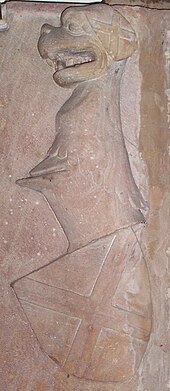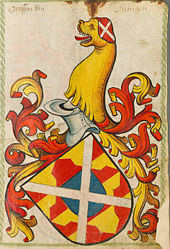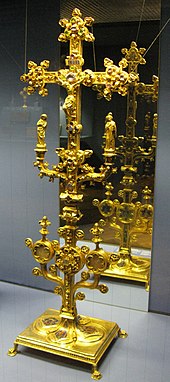Irmengard von Oettingen

Irmengard von Oettingen (* approx. 1310 ; † November 6, 1389 in Worms ) was a princess from the Counts of Oettingen , by marriage Countess Palatine near Rhine and as a widow Dominican .
Life
Countess Palatine
Irmengard von Oettingen was the daughter of Count Ludwig VI. von Oettingen (1288–1346) and his wife Agnes von Württemberg (1295–1317), a daughter of Eberhard the Illustrious , von Württemberg.
Around 1320 Princess Irmengard married Count Palatine Adolf the Honorable from the House of Wittelsbach . From 1319 until his death in 1327, he officially served as Count Palatine of the Rhine . However, his uncle Ludwig (IV.) Exercised the actual power of government .
The royal couple resided in Heidelberg under the sovereignty of Emperor Ludwig IV, but withdrew to Oggersheim around 1326 . Here, Count Palatine Adolf had the community, which had been destroyed by fire, rebuilt, surrounded by a rampart or ditch and elevated it to the status of town. The Count Palatine died in Neustadt an der Weinstrasse as early as January 1327 and was buried in the Cistercian monastery at Schönau near Heidelberg .
Count Palatine Adolf and Irmengard von Oettingen had 4 children:
- Ruprecht II (1325–1398), later elector of the Palatinate;
- Friedrich (died early);
- Adolf (died early);
- one daughter († 1389).
Widow and nun
In the year her husband died, Countess Palatine Irmengard retired with her children to the Liebenau monastery near Worms ; the latter received the Austrian-minded Count Johann von Nassau as guardian. In 1329, in the house contract of Pavia, a settlement between Ludwig IV., Bavaria and Count Palatine Adolf's brothers Rudolf II. And Ruprecht I. In place of his deceased father Adolf, the four-year-old son Ruprecht II entered the inheritance. After the death of his two uncles Rudolf II and Ruprecht I, he succeeded them as Count Palatine and Elector.
At first Irmengard von Oettingen only lived as a guest in the monastery. She entered there as a Dominican around 1344 and lived here as a nun until her death in 1389 (various sources also mention the year 1399). As early as 1344, the Liebenau nuns acquired "with the property brought in by their co-sister and choir sister Irmegard, the widow of Count Palatine Adolf" , from the Neuweiler Abbey in Alsace , patronage rights and tithe of St. Martin's Church in Einselthum , as well as the monastery courtyard and the so-called stone house there ; also estate in Rüssingen .
On December 1, 1381, in Liebenau, Countess Palatine Irmengard donated a Holy Mass, the so-called Convention Mass, to be sung every day.
Irmengard's brother Ludwig died in 1346 on a pilgrimage to the Holy Land. In his will he ordered a magnificent reliquary cross to be donated to the Liebenau monastery, which, according to the inscription, was made on behalf of the father. The cross came to Freiburg im Breisgau in a detour and is now in the treasury of the Augustinian Museum there .
Here in the Liebenau monastery, Irmengard's daughter-in-law Beatrix of Sicily-Aragon stayed with her for a time. The Dominican chronicler Johannes Meyer (1422–1482) reports that Countess Palatine Beatrix gave birth to her son Ruprecht in Liebenau and that Ruprecht was raised there by his grandmother Irmengard von Oettingen until he was 7 years old. Ruprecht, the later Elector Ruprecht III of the Palatinate. and German King Ruprecht I, had Irmengard's great niece Elisabeth von Oettingen as lady-in-waiting.
Palatine Countess Irmengard was buried in the Liebenau monastery, of which no remains have survived today. In his Historia episcopatus Wormatiensis, the historian Johann Friedrich Schannat handed down the funerary inscription, which no longer exists. It is noted in it that the princess lived as a religious sister for 40 years.
literature
- Johann Friedrich Schannat : Historia episcopatus Wormatiensis . 1734, p. 172
- Treatises of the Electoral Bavarian Academy of Sciences , Volume 3, 1765. Bavarian Academy of Sciences, Munich, books.google.de
- Jörg Rogge : “Fürstin und Fürst - family relationships and opportunities for action by noble women in the Middle Ages” , page 35, Verlag Thorbecke, 2004, ISBN 3-7995-4266-3 ; books.google.de
- Ingeborg Schroth: A reliquary cross from 1342 from Liebenau Monastery . In: Pantheon , No. 31, 1943, pp. 43-47, Rheinland-Pfälzische Bibliographie
Web links
- Genealogical page about Irmengard von Oettingen
- Genealogical page about Irmengard von Oettingen
- Website for the grave inscription of Count Palatine Irmengard in the Liebenau monastery
Individual evidence
- ^ Genealogical page on Count Ludwig VI. from Oettingen
- ^ Count Palatine Adolf and the city of Oggersheim
- ^ Count Palatine Adolf and his place of residence Oggersheim
- ↑ Countess Palatine Irmengard in the Liebenau monastery
- ^ Franz Xaver Glasschröder : Documents on the Palatinate Church History in the Middle Ages , Munich, 1903, pages 245 u. 246, diploma no. 594 u. 597
- ^ Liebenauer Messstiftung by the Countess Palatine Irmengard
- ↑ On the donation of the cross to the Liebenau monastery
- ^ Illustrated website on the Liebenauer Kreuz in Freiburg ( memento from July 29, 2012 in the Internet Archive ).
- ^ Peter Ochsenbein: Meyer, Johannes. In: Biographisch-Bibliographisches Kirchenlexikon (BBKL). Volume 5, Bautz, Herzberg 1993, ISBN 3-88309-043-3 , Sp. 1427-1429. - To the chronicle of the order Johannes Meyer
- ↑ Source on the birth of King Ruprecht I in the Liebenau Monastery, Worms
- ↑ Original scan of the epitaph from Schannat's Historia episcopatus Wormatiensis
- ↑ Source of the grave of the Countess Palatine in Liebenau
| personal data | |
|---|---|
| SURNAME | Irmengard von Oettingen |
| ALTERNATIVE NAMES | Irmingard von Oettingen; Irmgard von Oettingen |
| BRIEF DESCRIPTION | Countess Palatine near Rhine, wife of Count Palatine Adolf the Righteous |
| DATE OF BIRTH | around 1304 |
| DATE OF DEATH | November 6, 1389 |
| Place of death | Worms |

